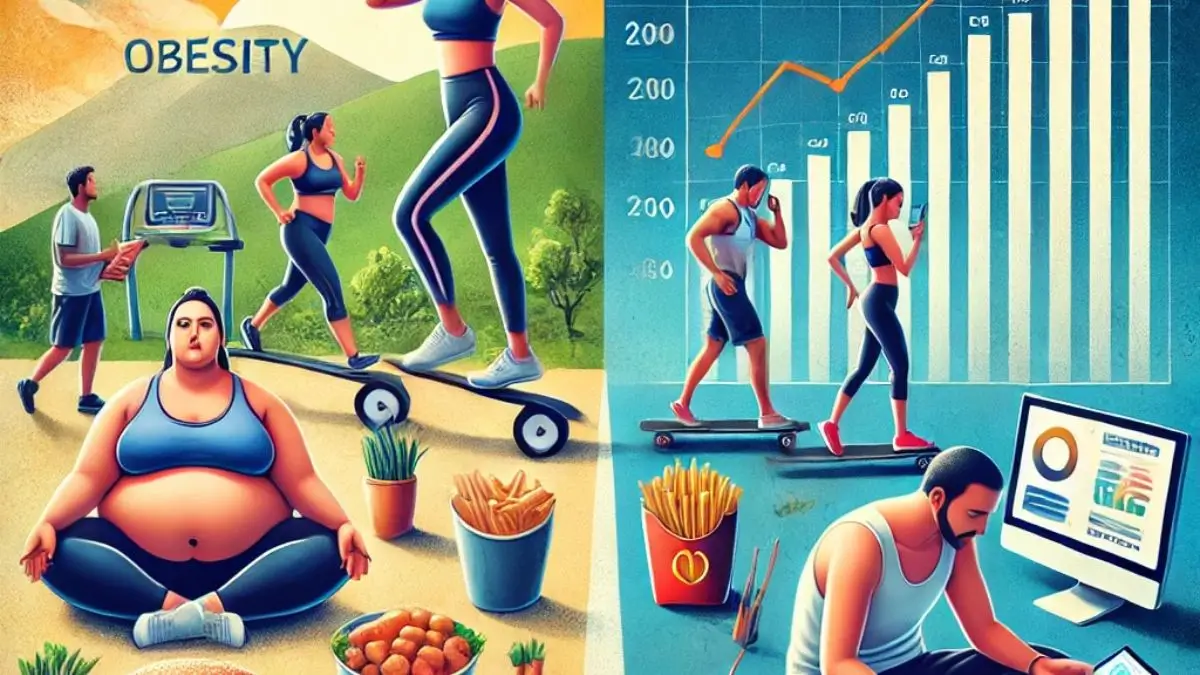A new study published in The Lancet predicts a significant rise in obesity in India, with nearly 44.9 crore people (21.8 crore men and 23.1 crore women) expected to be overweight or obese by 2050. This accounts for almost one-third of India’s projected population. The study also highlights a global crisis, estimating that by 2050, over half of all adults and a third of children will be overweight or obese.
Key Findings from the Study
Rising Obesity in India
- By 2050, 44.9 crore Indians are expected to be overweight or obese.
- India had the highest number of overweight or obese young adults in 2021, surpassing China and the U.S.
Obesity Among Adolescents (Ages 15-24)
- Young men: 0.4 crore (1990) → 1.68 crore (2021) → 2.27 crore (2050).
- Young women: 0.33 crore (1990) → 1.3 crore (2021) → 1.69 crore (2050).
Obesity Among Children
- Boys: 0.46 crore (1990) → 1.3 crore (2021) → 1.6 crore (2050).
- Girls: 0.45 crore (1990) → 1.24 crore (2021) → 1.44 crore (2050).
Why is Obesity Increasing?
- Dietary Changes: Shift towards processed foods high in sugar, salt, and unhealthy fats.
- Multinational Fast-Food Expansion: Major food companies are targeting low and middle-income countries like India.
Lifestyle Factors
- Urbanization → Reduced physical activity and increased sedentary jobs.
- Work Stress & Poor Sleep → Linked to weight gain and obesity.
Health Consequences of Rising Obesity
- Increased risk of Type 2 diabetes, cardiovascular diseases, and certain cancers.
- Burden on India’s healthcare system, already dealing with infectious diseases and malnutrition.
- Early childhood malnutrition may lead to obesity in adulthood, increasing long-term health risks.
What Needs to Be Done?
- Recognize Obesity as a Major Non-Communicable Disease (NCD).
Comprehensive National Obesity Program
- Awareness campaigns and school-based interventions.
- Workplace wellness programs to encourage a healthy lifestyle.
- Taxation on unhealthy foods to discourage their consumption.
Stronger Public Health Policies
- Only 40% of countries have policies to address obesity.
- For low-income countries, this drops to just 10%.
- Create a National Obesity Registry to track trends and interventions.
| Summary/Static | Details |
| Why in the news? | Lancet: 1 in 3 Indians Could Be Obese by 2050 |
| Total Overweight/Obese Population (2050) | 44.9 crore (21.8 crore men & 23.1 crore women) |
| Young Men (15-24 years) | 1990: 0.4 crore → 2021: 1.68 crore → 2050: 2.27 crore |
| Young Women (15-24 years) | 1990: 0.33 crore → 2021: 1.3 crore → 2050: 1.69 crore |
| Obese/Overweight Boys | 1990: 0.46 crore → 2021: 1.3 crore → 2050: 1.6 crore |
| Obese/Overweight Girls | 1990: 0.45 crore → 2021: 1.24 crore → 2050: 1.44 crore |
| Global Projection (2050) | Half of all adults & one-third of children will be overweight/obese |
| Main Causes | Processed food, urbanization, sedentary jobs, stress, lack of policies |
| Health Risks | Diabetes, heart diseases, cancers, burden on healthcare system |
| Recommended Actions | National obesity program, awareness campaigns, food taxes, wellness programs, stronger policies |



 Asia Power Index 2025, India Ranks 3rd A...
Asia Power Index 2025, India Ranks 3rd A...
 World’s Strongest Passport in 2025 Revea...
World’s Strongest Passport in 2025 Revea...
 TIME Magazine Names ‘Architects of AI’ a...
TIME Magazine Names ‘Architects of AI’ a...







